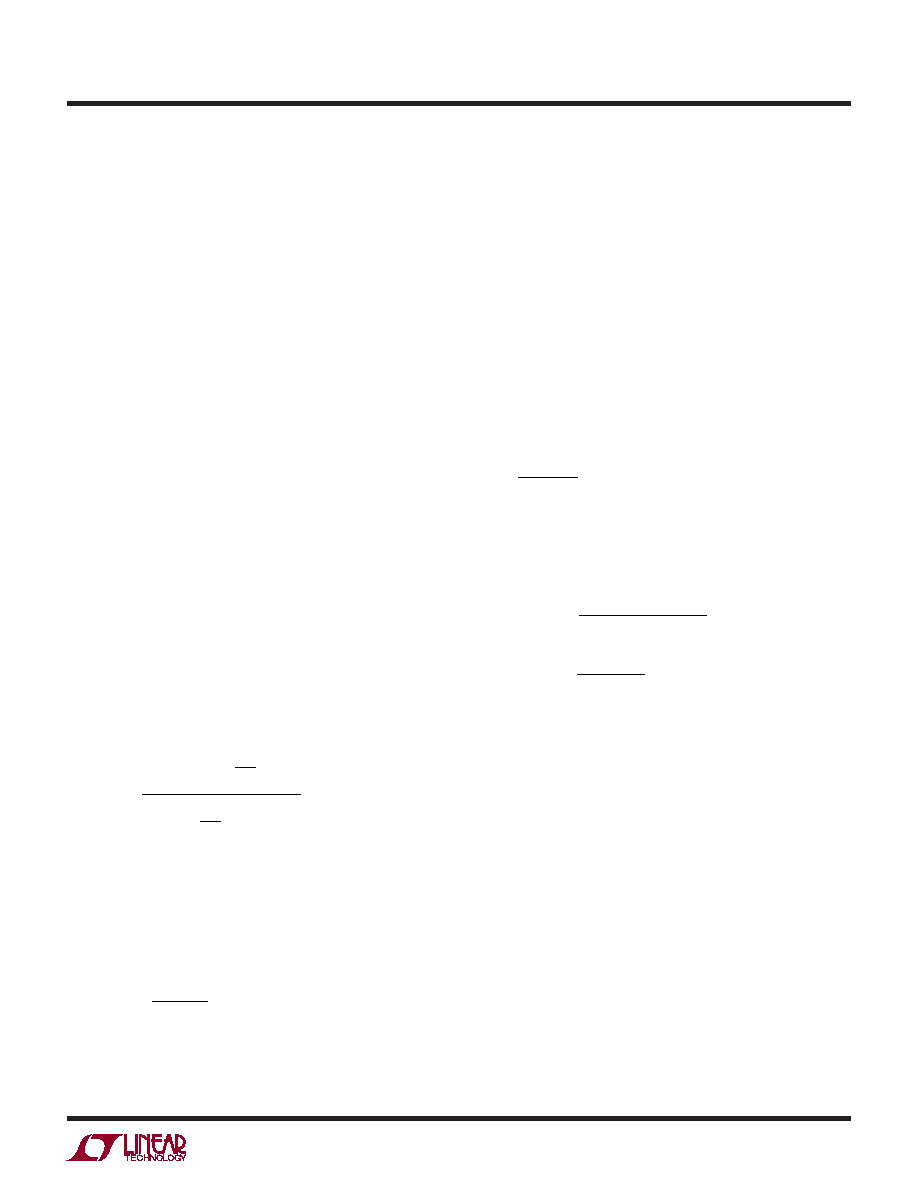- 您現(xiàn)在的位置:買賣IC網(wǎng) > PDF目錄44987 > LT3958IUHE#PBF (LINEAR TECHNOLOGY CORP) SWITCHING REGULATOR, PQCC36 PDF資料下載
參數(shù)資料
| 型號(hào): | LT3958IUHE#PBF |
| 廠商: | LINEAR TECHNOLOGY CORP |
| 元件分類: | 穩(wěn)壓器 |
| 英文描述: | SWITCHING REGULATOR, PQCC36 |
| 封裝: | 5 X 6 MM, LEAD FREE, PLASTIC, QFN-36 |
| 文件頁(yè)數(shù): | 9/28頁(yè) |
| 文件大小: | 320K |
| 代理商: | LT3958IUHE#PBF |
第1頁(yè)第2頁(yè)第3頁(yè)第4頁(yè)第5頁(yè)第6頁(yè)第7頁(yè)第8頁(yè)當(dāng)前第9頁(yè)第10頁(yè)第11頁(yè)第12頁(yè)第13頁(yè)第14頁(yè)第15頁(yè)第16頁(yè)第17頁(yè)第18頁(yè)第19頁(yè)第20頁(yè)第21頁(yè)第22頁(yè)第23頁(yè)第24頁(yè)第25頁(yè)第26頁(yè)第27頁(yè)第28頁(yè)

LT3958
17
3958f
APPLICATIONS INFORMATION
According to the preceding equations, the user has relative
freedom in selecting the switch duty cycle or turns ratio to
suit a given application. The selections of the duty cycle
and the turns ratio are somewhat iterative processes, due
to the number of variables involved. The user can choose
either a duty cycle or a turns ratio as the start point. The
following trade-offs should be considered when select-
ing the switch duty cycle or turns ratio, to optimize the
converter performance. A higher duty cycle affects the
yback converter in the following aspects:
Lower MOSFET RMS current ISW(RMS), but higher
MOSFET VSW peak voltage
Lower diode peak reverse voltage, but higher diode
RMS current ID(RMS)
Higher transformer turns ratio (NP/NS)
It is recommended to choose a duty cycle between 20%
and 80%.
Flyback Converter: Maximum Output Current
Capability and Transformer Design
The maximum output current capability and transformer
design for continuous conduction mode (CCM) is chosen
as presented here.
The maximum duty cycle (DMAX)occurswhentheconverter
has the minimum VIN:
DMAX =
VOUT
NP
NS
VOUT
NP
NS
+ VIN(MIN)
Due to the current limit of its internal power switch, the
LT3958 should be used in a yback converter whose maxi-
mum output current (IO(MAX)) is less than the maximum
output current capability by a sufcient margin (10% or
higher is recommended):
IO(MAX) ≤
VIN(MIN)
VOUT
DMAX 3.3A 0.5 ΔISW
(
)
The transformer ripple current
ΔISW has a direct effect on
the design/choice of the transformer and the converter’s
output current capability. Choosing smaller values of
ΔISW
increases the output current capability, but requires large
primary and secondary inductances and reduce the cur-
rent loop gain (the converter will approach voltage mode).
Accepting larger values of
ΔISW allows the use of low
primary and secondary inductances, but results in higher
input current ripple, greater core losses, and reduces the
output current capability. It is recommended to choose a
ΔISW higher than 0.6A.
Given an operating input voltage range, and having chosen
the operating frequency and ripple current in the primary
winding, the primary winding inductance can be calculated
using the following equation:
L =
VIN(MIN)
ΔISW
DMAX
The primary winding peak current is the switch current
limit (typical 4A). The primary and secondary maximum
RMS currents are:
ILP(RMS) ≈
POUT(MAX)
DMAX VIN(MIN) η
ILS(RMS) ≈
IOUT(MAX)
1DMAX
where
η is the converter efciency.
Based on the preceding equations, the user should de-
sign/choose the transformer having sufcient saturation
and RMS current ratings.
Flyback Converter: Snubber Design
Transformer leakage inductance (on either the primary
or secondary) causes a voltage spike to occur after the
MOSFET turn-off. This is increasingly prominent at higher
load currents, where more stored energy must be dis-
sipated. In some cases a snubber circuit will be required
to avoid overvoltage breakdown at the MOSFET’s drain
node. There are different snubber circuits (such as RC
snubber, RCD snubber, etc.) and Application Note 19 is
a good reference on snubber design. An RCD snubber is
shown in Figure 6.
相關(guān)PDF資料 |
PDF描述 |
|---|---|
| LT3958EUHE#PBF | SWITCHING REGULATOR, PQCC36 |
| LT3958EUHE#TRPBF | SWITCHING REGULATOR, PQCC36 |
| LT4180MPGN#PBF | POWER SUPPLY SUPPORT CKT, PDSO24 |
| LT4180IGN#PBF | POWER SUPPLY SUPPORT CKT, PDSO24 |
| LT4180EGN#TRPBF | POWER SUPPLY SUPPORT CKT, PDSO24 |
相關(guān)代理商/技術(shù)參數(shù) |
參數(shù)描述 |
|---|---|
| LT3958IUHETRPBF | 制造商:LINER 制造商全稱:Linear Technology 功能描述:High Input Voltage, Boost, Flyback, SEPIC and Inverting Converter |
| LT3959 | 制造商:LINER 制造商全稱:Linear Technology 功能描述:Wide Input Voltage Range Boost/SEPIC/Inverting Converter with 6A, 40V Switch |
| LT3959EFE#PBF | 制造商:Linear Technology 功能描述:IC REG MULTI CONFIG ADJ 38TSSOP |
| LT3959EFE#PBF | 制造商:Linear Technology 功能描述:DC-DC CONV BOOST/INVERTING TSSOP-38 制造商:Linear Technology 功能描述:DC-DC CONV, BOOST/INVERTING, TSSOP-38 |
| LT3959EFE#TRPBF | 制造商:Linear Technology 功能描述:IC REG MULTI CONFIG ADJ 38TSSOP |
發(fā)布緊急采購(gòu),3分鐘左右您將得到回復(fù)。